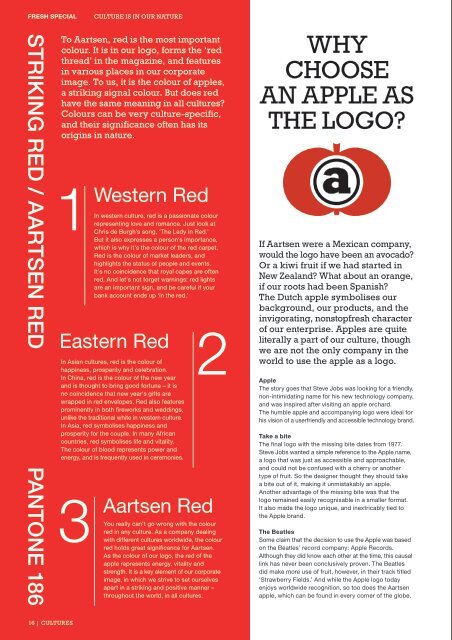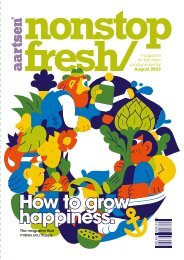Magazine_October_2023
Create successful ePaper yourself
Turn your PDF publications into a flip-book with our unique Google optimized e-Paper software.
FRESH SPECIAL<br />
CULTURE IS TITEL IN OUR VAN NATURE HET STUK<br />
STRIKING RED / AARTSEN RED PANTONE 186<br />
To Aartsen, red is the most important<br />
colour. It is in our logo, forms the ‘red<br />
thread’ in the magazine, and features<br />
in various places in our corporate<br />
image. To us, it is the colour of apples,<br />
a striking signal colour. But does red<br />
have the same meaning in all cultures?<br />
Colours can be very culture-specific,<br />
and their significance often has its<br />
origins in nature.<br />
1<br />
Western<br />
Eastern Red<br />
In Asian cultures, red is the colour of<br />
happiness, prosperity and celebration.<br />
In China, red is the colour of the new year<br />
and is thought to bring good fortune – it is<br />
no coincidence that new year's gifts are<br />
wrapped in red envelopes. Red also features<br />
prominently in both fireworks and weddings,<br />
unlike the traditional white in western culture.<br />
In Asia, red symbolises happiness and<br />
prosperity for the couple. In many African<br />
countries, red symbolises life and vitality.<br />
The colour of blood represents power and<br />
energy, and is frequently used in ceremonies.<br />
3<br />
Aartsen<br />
Red<br />
In western culture, red is a passionate colour<br />
representing love and romance. Just look at<br />
Chris de Burgh's song, ‘The Lady in Red.’<br />
But it also expresses a person's importance,<br />
which is why it's the colour of the red carpet.<br />
Red is the colour of market leaders, and<br />
highlights the status of people and events.<br />
It's no coincidence that royal capes are often<br />
red. And let's not forget warnings: red lights<br />
are an important sign, and be careful if your<br />
bank account ends up ‘in the red.’<br />
2<br />
Red<br />
You really can't go wrong with the colour<br />
red in any culture. As a company dealing<br />
with different cultures worldwide, the colour<br />
red holds great significance for Aartsen.<br />
As the colour of our logo, the red of the<br />
apple represents energy, vitality and<br />
strength. It is a key element of our corporate<br />
image, in which we strive to set ourselves<br />
apart in a striking and positive manner –<br />
throughout the world, in all cultures.<br />
WHY<br />
CHOOSE<br />
AN APPLE AS<br />
THE LOGO?<br />
If Aartsen were a Mexican company,<br />
would the logo have been an avocado?<br />
Or a kiwi fruit if we had started in<br />
New Zealand? What about an orange,<br />
if our roots had been Spanish?<br />
The Dutch apple symbolises our<br />
background, our products, and the<br />
invigorating, nonstopfresh character<br />
of our enterprise. Apples are quite<br />
literally a part of our culture, though<br />
we are not the only company in the<br />
world to use the apple as a logo.<br />
Apple<br />
The story goes that Steve Jobs was looking for a friendly,<br />
non-intimidating name for his new technology company,<br />
and was inspired after visiting an apple orchard.<br />
The humble apple and accompanying logo were ideal for<br />
his vision of a userfriendly and accessible technology brand.<br />
Take a bite<br />
The final logo with the missing bite dates from 1977.<br />
Steve Jobs wanted a simple reference to the Apple name,<br />
a logo that was just as accessible and approachable,<br />
and could not be confused with a cherry or another<br />
type of fruit. So the designer thought they should take<br />
a bite out of it, making it unmistakably an apple.<br />
Another advantage of the missing bite was that the<br />
logo remained easily recognisable in a smaller format.<br />
It also made the logo unique, and inextricably tied to<br />
the Apple brand.<br />
The Beatles<br />
Some claim that the decision to use the Apple was based<br />
on the Beatles’ record company: Apple Records.<br />
Although they did know each other at the time, this causal<br />
link has never been conclusively proven. The Beatles<br />
did make more use of fruit, however, in their track titled<br />
‘Strawberry Fields.’ And while the Apple logo today<br />
enjoys worldwide recognition, so too does the Aartsen<br />
apple, which can be found in every corner of the globe.<br />
16 | CULTURES

















